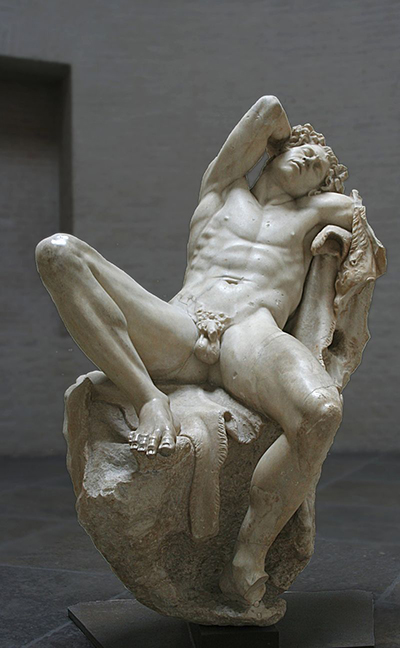Barberini Faun is a life-size marble statue located in Glyptothek, a museum found in Munich. A Faun is known to be the Roman equivalent of the Greek Satyr (silenos).
In Greek mythology, a satyr was a human-like male woodland spirit that has several animal features, usually horns, ears, hooves or goat-like tail. Satyrs attended Dionysus, who is the god of theatre, religious ecstasy, ritual madness, of fertility, winemaking as well as wine and of the grape-harvest.
Barberini Faun was carved in the early second or late third century BC by an unknown Hellenistic sculptor from the Pergamene school, or it's a Roman high-quality copy, although it was given its present form by several restorers in Rome, which ended with Vincenzo Pacetti. This sculpture was found in the 2nd millennium (the1620s) in a moat below The Mausoleum of Hadrian (Castel Sant'Angelo) in Rome.
In 1624, Barberini Pope Urban VIII undertook work on the fortification. The statue made its first ever documented appearance on 6 June 1628, in its restoration receipt, when Cardinal Francesco Barberini (the Pope's nephew) was already the owner. When discovered, the sculpture was heavily damaged: parts of the head, parts of both hands and the right leg were all missing. Procopius, a historian, recorded that during the year 537 siege of Rome, the defenders hurled down the statue upon the Goths. Johann Winckelmann thought that the discovery place and the condition of the statue suggested it was such a projectile.
Maffeo Barberini, an Italian Catholic Cardinal, commissioned the Italian sculptor Gianlorenzo Bernini to restore this statue. Several restorations were made on the sculpture; the left leg of the antique was reaffixed, the right leg was later restored in marble. Today, the statue is shown without the left arm that was restored.
The Barberini Faun restorations enhanced the statue's sexual aspect, and because of that, it has earned a reputation as an erotic art example. In Greek art, nudity was nothing new, but the unconcealed sexuality of this particular work makes it most appealing to 20th-century eyes. The wantonly spread legs of the statue focus attention on his private parts. The statue was reproduced in the 1830s on a Nymphenburg Porcelain Manufactory service.
The sculpture was housed in the 17th-century palace Palazzo Barberini in Rome until the restorer and sculptor Vincenzo Pacetti purchased it in 1799. Pacetti offered the statue to various French and English clients. The Barberini brought forward suit to annul this sale and finally sold the sculpture, after public competition plus a ban on the statue exportation, which was strongly supported by Antonio Canova and Carlo Fea - to Crown Prince of Bavaria, Ludwig. Ludwig planned a special room that Leo von Klenze designed before finalising the purchase. By 1827, it was in that place. In 1830, the Glyptothek opened to house Ludwig's statue collection.
In 1726, Edmé Bouchardon sculpted a marble copy. Cardinal Barberini wanted a plaster cast of the sculpture to keep it with the antique original. In 1732, the copy arrived in France and was greatly admired. The duc de Chartres purchased it for his elaborate Parc Monceau garden plan. It's now in the world's largest art museum called Louvre Museum. In 1846, Eugène-Louis Lequesne made a copy, and it was given to France. It's now in one of several influential art schools, ENSBA.




